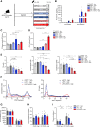Identification of a Gain-of-Function LIPC Variant as a Novel Cause of Familial Combined Hypocholesterolemia
- PMID: 35899625
- PMCID: PMC9439636
- DOI: 10.1161/CIRCULATIONAHA.121.057978
Identification of a Gain-of-Function LIPC Variant as a Novel Cause of Familial Combined Hypocholesterolemia
Abstract
Background: Atherosclerotic cardiovascular disease is the main cause of mortality worldwide and is strongly influenced by circulating low-density lipoprotein (LDL) cholesterol levels. Only a few genes causally related to plasma LDL cholesterol levels have been identified so far, and only 1 gene, ANGPTL3, has been causally related to combined hypocholesterolemia. Here, our aim was to elucidate the genetic origin of an unexplained combined hypocholesterolemia inherited in 4 generations of a French family.
Methods: Using next-generation sequencing, we identified a novel dominant rare variant in the LIPC gene, encoding for hepatic lipase, which cosegregates with the phenotype. We characterized the impact of this LIPC-E97G variant on circulating lipid and lipoprotein levels in family members using nuclear magnetic resonance-based lipoprotein profiling and lipidomics. To uncover the mechanisms underlying the combined hypocholesterolemia, we used protein homology modeling, measured triglyceride lipase and phospholipase activities in cell culture, and studied the phenotype of APOE*3.Leiden.CETP mice after LIPC-E97G overexpression.
Results: Family members carrying the LIPC-E97G variant had very low circulating levels of LDL cholesterol and high-density lipoprotein cholesterol, LDL particle numbers, and phospholipids. The lysophospholipids/phospholipids ratio was increased in plasma of LIPC-E97G carriers, suggestive of an increased lipolytic activity on phospholipids. In vitro and in vivo studies confirmed that the LIPC-E97G variant specifically increases the phospholipase activity of hepatic lipase through modification of an evolutionarily conserved motif that determines substrate access to the hepatic lipase catalytic site. Mice overexpressing human LIPC-E97G recapitulated the combined hypocholesterolemic phenotype of the family and demonstrated that the increased phospholipase activity promotes catabolism of triglyceride-rich lipoproteins by different extrahepatic tissues but not the liver.
Conclusions: We identified and characterized a novel rare variant in the LIPC gene in a family who presents with dominant familial combined hypocholesterolemia. This gain-of-function variant makes LIPC the second identified gene, after ANGPTL3, causally involved in familial combined hypocholesterolemia. Our mechanistic data highlight the critical role of hepatic lipase phospholipase activity in LDL cholesterol homeostasis and suggest a new LDL clearance mechanism.
Keywords: LIPC protein, human; Lipc protein, mouse; cholesterol, HDL; cholesterol, LDL; phospholipases.
Figures






Comment in
-
LIPC variant in combined hypocholesterolaemia.Nat Rev Cardiol. 2022 Oct;19(10):642. doi: 10.1038/s41569-022-00765-y. Nat Rev Cardiol. 2022. PMID: 35978009 No abstract available.
-
Gain-of-Function Variants in Lipid Genes Enhance Biological Insight and Point Toward Therapeutic Opportunities.Circulation. 2022 Sep 6;146(10):740-742. doi: 10.1161/CIRCULATIONAHA.122.061233. Epub 2022 Sep 6. Circulation. 2022. PMID: 36067277 Free PMC article. No abstract available.
References
-
- Borén J, Chapman MJ, Krauss RM, Packard CJ, Bentzon JF, Binder CJ, Daemen MJ, Demer LL, Hegele RA, Nicholls SJ, et al. . Low-density lipoproteins cause atherosclerotic cardiovascular disease: pathophysiological, genetic, and therapeutic insights: a consensus statement from the European Atherosclerosis Society Consensus Panel. Eur Heart J. 2020;41:2313–2330. doi: 10.1093/eurheartj/ehz962 - PMC - PubMed
-
- Dagenais GR, Leong DP, Rangarajan S, Lanas F, Lopez-Jaramillo P, Gupta R, Diaz R, Avezum A, Oliveira GBF, Wielgosz A, et al. . Variations in common diseases, hospital admissions, and deaths in middle-aged adults in 21 countries from five continents (PURE): a prospective cohort study. Lancet. 2020;395:785–794. doi: 10.1016/S0140-6736(19)32007-0 - PubMed
-
- Berberich AJ, Hegele RA. The complex molecular genetics of familial hypercholesterolaemia. Nat Rev Cardiol. 2019;16:9–20. doi: 10.1038/s41569-018-0052-6 - PubMed
-
- Balder JW, Rimbert A, Zhang X, Viel M, Kanninga R, Van DIjk F, Lansberg P, Sinke R, Kuivenhoven JA. Genetics, lifestyle, and low-density lipoprotein cholesterol in young and apparently healthy women. Circulation. 2018;137:820–831. doi: 10.1161/CIRCULATIONAHA.117.032479 - PubMed
Publication types
MeSH terms
Substances
LinkOut - more resources
Full Text Sources
Other Literature Sources
Medical
Molecular Biology Databases
Miscellaneous

